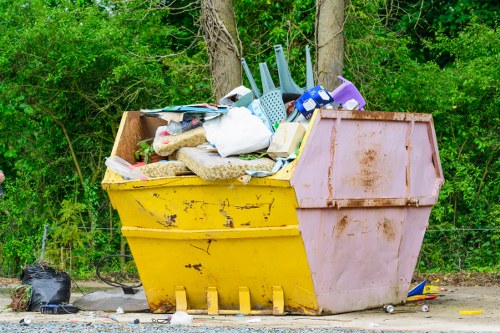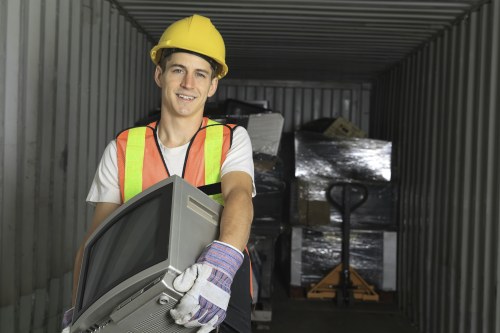Furniture Removal and Collection in Rubbish Clearances: Streamlining Sustainable Transitions
Introduction to Furniture Removal and Collection in Rubbish Clearances

The modern world is marked by rapid changes in lifestyle, increased urbanization, and a constant need to optimize living and working spaces. Furniture removal and collection in rubbish clearances have therefore become essential services that not only simplify the process of decluttering but also promote environmental sustainability. In this evolving sector, companies are committed to ensuring that outdated or unwanted furniture is responsibly collected, recycled, or disposed of, preventing unnecessary waste and giving old items new life.
Across metropolitan areas and suburban communities alike, the significance of professionally conducted furniture removal has grown noticeably. With the increasing awareness of environmental issues and the need for responsible rubbish clearance, individuals and businesses are opting for services that ensure their unwanted furniture does not end up in landfill sites. This trend is being driven by both eco-conscious consumers and the rising costs associated with landfill management. Ultimately, these services contribute to the circular economy by promoting reuse and recycling over mere disposal.
Moreover, the integration of technology with traditional clearance methods has enabled companies to offer quicker, safer, and more efficient removal processes. Advanced scheduling tools, real-time tracking, and eco-friendly methods are now standard in the industry. This blend of technology and sustainability also fosters customer trust and guarantees that each removal is handled with the utmost care and compliance with environmental regulations. Efficient, responsible, and innovative represents the motto of many professionals working within this essential sector.
The Growing Importance of Eco-Friendly Furniture Clearance

In recent years, the industry of furniture removal and rubbish clearances has undergone a remarkable transformation. A notable shift is seen in the emphasis on eco-friendly practices that reduce the environmental impact of disposing of bulky items. This approach not only aligns with global sustainability goals but also offers economic benefits by reducing waste management costs and encouraging recycling. Service providers now routinely implement systematic protocols to minimize energy use and optimize resource recovery. Eco-responsible solutions are thus at the heart of modern clearance practices.
Businesses and homeowners alike are now more educated about the environmental costs associated with hardware and furniture disposal. As such, many have begun to favor providers that follow green disposal policies. When furniture is collected in conjunction with rubbish clearances, the process is streamlined, allowing for the separation of hazardous components and recyclable materials gently. This means that what used to be seen as a simple removal task is now a structured system designed to support environmental regeneration and to optimize waste utilization.
Additionally, community initiatives and governmental regulations further encourage the adoption of sustainable practices. Financial incentives, grants, and local tax benefits are offered to companies and individuals who engage in meaningful recycling efforts. As a result, by choosing services in furniture removal and rubbish clearances, customers are making a dual investment – one in enhancing their living spaces and another in protecting our planet's resources. This integrated approach emphasizes quality of life and fosters a positive, eco-conscious impact on communities and broader ecosystems.
Planning Your Furniture Removal: Steps and Strategies

Proper planning is the cornerstone of effective furniture removal and collection in rubbish clearances. Preparing for a clearance project begins with a detailed evaluation of the items to be removed and understanding which pieces can be recycled, donated, or safely disposed of. To start, customers are encouraged to inventory their possessions, including measurements and conditions of each piece. This thorough inventory helps service providers tailor their approach to meet specific requirements, ensuring not only efficiency but also adherence to environmental standards.
Before scheduling a pickup, consider the following essential steps: Organize your items, sort out what needs repair or recycling, and prepare an adequate space for workers to operate efficiently. Making a clear list of potential obstacles and gathering any necessary paperwork, such as permits or recycling guidelines, are also key. In many cases, professional organizations supply a checklist to help residents or businesses sort their belongings effectively. By following these guidelines, the clearance process can proceed without unexpected interruptions.
Furthermore, planning should also address logistical details such as the day and time for removal, access routes, and parking arrangements for the collection vehicles. A well-prepared plan can significantly reduce delays and complications. Strategic planning not only minimizes disruptions but also ensures that all items are handled safely and in accordance with regulatory standards. Using bullet lists or checklists, such as the following, can greatly enhance clarity:
- Assess the type of furniture to be removed.
- Create a comprehensive inventory.
- Schedule a consultation with clearance professionals.
- Identify recycle and disposal guidelines.
- Prepare the site for smooth access and removal.
Detailing the Process: From Collection to Recycling

The process of furniture removal and collection in rubbish clearances involves several critical stages that ensure items are not only removed from the premises efficiently but are also processed in an environmentally friendly manner. After the planning phase, a professional team arrives with the appropriate tools and vehicles to handle bulky furniture. The initial phase includes an assessment of the items, during which the team identifies pieces that can be repurposed, recycled, or require special disposal methods.
A systematic collection approach is vital for preventing damage and ensuring safety. Often, the removal process is split into stages—first, a careful extraction from the room, then moving the items outside, followed by safe transportation to designated recycling or disposal sites. Companies typically follow strict protocols in line with manufacturing and environmental standards. To bolster safety, workers are trained to handle items in a manner that minimizes impact on both the property and the environment. Clear communication between the service provider and the customer is essential during this process, ensuring that any special instructions or concerns are addressed immediately.
Moreover, sustainability is woven into every step of the process. Providers make a concerted effort to recycle usable materials and refurbish furniture when possible. In addition to standard removal procedures, many companies have dedicated teams for processing materials to meet recycling targets. This green initiative not only reduces landfill contributions but also creates opportunities for reusing valuable resources.
Safety and Compliance Considerations
are also critical, so service providers regularly update their practices to comply with the latest health, safety, and environmental regulations. Lists of best practices might include:- Proper labeling and sorting of items upon removal.
- Using energy-efficient vehicles for transportation.
- Ensuring that all hazardous materials are handled by specialists.
- Maintaining clear documentation throughout the clearance process.
Service Excellence: Ensuring Quality in Rubbish Clearances

As customer expectations continue to rise, providers specializing in furniture removal and collection in rubbish clearances are constantly evolving to deliver excellent service quality. The emphasis on superior customer service entails thorough consultations, timely service, and a transparent pricing structure. With a customer-first approach, these companies ensure that every stage of the removal process is clearly communicated and executed with professionalism.
Service excellence in this industry also involves a significant commitment to after-service support. This includes detailed follow-up procedures, customization of services based on specific client needs, and providing expert advice on how to manage waste more sustainably in the future. By focusing on quality and responsiveness, companies build trust and encourage clients to become repeat customers. Reliability, efficiency, and professionalism are qualities that differentiate top-tier service providers in this competitive market.
Finally, embracing innovative technologies can further enhance the customer experience. Whether it is through digital scheduling, real-time tracking, or the use of eco-friendly equipment, the modern approach to furniture removal and rubbish clearances ensures each client's experience is smooth and hassle-free. Clients are not only assured of a successful clearance but are also encouraged to engage in sustainable practices. Book your service now and see the difference that professionally managed removal and eco-conscious recycling can make in your space. Contact us today to experience the pinnacle of service quality in this rapidly evolving field.
Additional Insights: Furniture removal and collection in rubbish clearances is more than just a service—it is a commitment to a sustainable future. It illustrates how industries can adopt eco-friendly policies, provide innovative solutions, and ensure that waste is managed in the most responsible manner possible. For businesses and individuals alike, understanding this process is the key to making informed decisions that benefit the community and the planet.
The transition from clutter to clarity begins with recognizing the critical role that professional clearance services play. Residents switching from traditional disposal methods to more conscientious practices are setting an example of environmental stewardship. In an era where digital solutions and green initiatives are combined for maximum efficacy, every step taken towards sustainable furniture removal matters.
Engaging with professional clearance services encourages a broader perspective on waste management. It underscores the importance of recycling, the viability of repurposing, and the economic advantages of reduced waste collection fees. Moreover, this approach fosters a community’s overall well-being by streamlining processes that once contributed significantly to urban rubbish accumulation.
Whether it's preparing for a major move, decluttering a long-forgotten attic, or simply upgrading office spaces, the impact of furniture removal and collection in rubbish clearances goes far beyond aesthetics. It is a proactive solution addressing environmental challenges and offering long-term benefits.
By combining innovative techniques and traditional expertise, today's removal services are bridging the gap between effective waste management and environmental responsibility. This synergy is crucial for communities striving for a greener future.
The progressive methodology adopted by clearance companies is setting new industry standards. These standards are continuously refined to meet evolving regulatory requirements and market demands while prioritizing sustainable practices.
Increased public interest in sustainable living is spurring businesses to seek out clearance services that align with these values. As more people understand the relationship between waste management and environmental health, demand for eco-friendly solutions is expected to rise steadily.
Ultimately, the integration of robust planning, detailed processes, and a commitment to sustainability positions furniture removal and collection in rubbish clearances as a forward-thinking solution. Making informed choices in this area benefits not only the individual but also contributes significantly to community environmental goals.
The synergy between modern technology and established methods has proven to be a game-changer. With systems designed for both efficiency and safety, the removal services are now more reliable than ever before.
Looking ahead, continuous improvements in service delivery and regular updates to clearance protocols will further enhance the effectiveness of rubbish clearances. Future initiatives are expected to incorporate even more advanced technology and sustainable practices.
This evolving industry serves as a model for how services can be reimagined in the modern world. By focusing on clear, systematic removal processes and integrating sustainability, businesses are showing that even seemingly mundane tasks can have a substantial, positive impact on our environment.
Every step taken in furniture removal not only clears unwanted clutter but also contributes to the collective effort of maintaining a cleaner, greener world. With each removal, the importance of professional handling and eco-friendly practices becomes increasingly apparent.